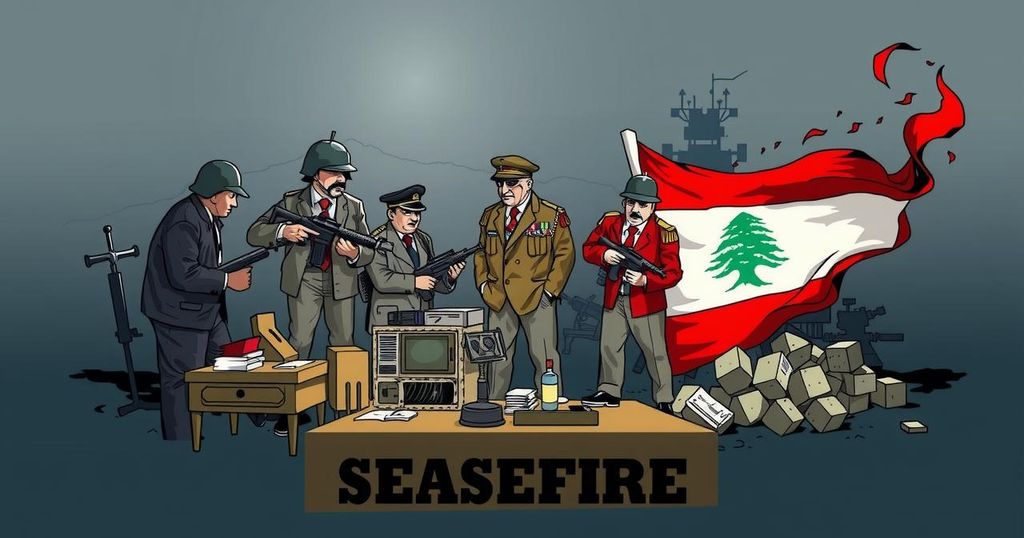The ceasefire between Israel and Hezbollah in Lebanon indicates a setback for Iran, revealing the limitations of its proxy warfare strategy. Following significant military losses inflicted by Israeli operations, Iran appears compelled to push for diplomatic resolutions to maintain its regional standing. As Hezbollah faces Israeli scrutiny and potential military action, the situation has created challenges for Iranian influence, exacerbated by domestic economic pressures and changing international relations.
The recent ceasefire agreement between Israel and Hezbollah in Lebanon not only aims to halt the ongoing violence but also signifies a notable setback for Iran, the primary supporter of Hezbollah. This ceasefire comes after months of conflict ignited by Hezbollah’s missile attacks on northern Israeli civilians, demonstrating Iran’s proxy warfare strategy by funding and equipping militant groups to act on its behalf.
Iran’s decision to avoid direct confrontation with Israel stems from an understanding of its military disadvantage. Instead, it supports organizations like Hezbollah and Hamas to further its agenda while remaining distanced from direct engagement. This strategic involvement was evident when Hezbollah escalated its attacks following Hamas’s offensive against Israel in October, signaling Iran’s backing without overt involvement.
The Israeli Defense Forces (IDF) have significantly degraded Hezbollah’s operational capabilities during “Operation Northern Arrows,” destroying key infrastructure, including tunnels and missile launch sites, which represents a profound humiliation for Iran. The inability of the Iranian regime to shield its proxies from Israel’s effective military operations has raised substantial concerns about its influence and credibility in the region.
Amidst these military setbacks, Iran faces increasing domestic discontent, prompting a shift towards diplomatic efforts to stabilize the situation in Lebanon. Indications suggest that Iran has been the driving force in negotiating the ceasefire, seeking to safeguard its regional standing, while Hezbollah, keen on continuing its confrontations, showed resistance right until the ceasefire’s implementation.
The future of the ceasefire hinges on Hezbollah’s actions; they continue to threaten Israel, prompting warnings from Israeli officials regarding potential aggressive responses should Hezbollah attempt to regroup. This back-and-forth dynamic illustrates the precarious situation in which Iran finds itself, as both its proxies, Hezbollah and Hamas, remain resolute in their opposition to Israel despite incurring severe losses.
The fragility of Iran’s influence is further exacerbated by the potential for the Lebanese government to assume responsibility for national defense, signaling a rejection of Iranian influence. As the regional landscape shifts, analysts predict substantial implications for the stability of the Iranian regime, given the heavy economic burdens shouldered by its citizens amidst high inflation rates and notable unemployment.
Finally, with changes expected in U.S. policy under the incoming administration, it is anticipated that the ceasefire could be a harbinger of more significant political shifts undermining Iran’s position in the Middle East. The prospect of further isolation looms large, reinforcing the theory advanced by opposition leaders regarding the Iranian regime’s declining viability.
The recent ceasefire in Lebanon has opened discussions about the implications of Iranian influence in the region. Historically, Iran has positioned itself as a major supporter of both Hezbollah and Hamas. By funding and armament, Iran has utilized these factions as proxies to challenge Israel while avoiding direct military engagements. The ongoing conflict and subsequent ceasefire reflect the shifting dynamics in Middle Eastern politics, particularly regarding the power balance between Iranian-backed groups and Israeli military responses. Economic challenges within Iran and the changing landscape of international relations further complicate this issue, inviting questions about the future of Iranian authority in the region.
In conclusion, the ceasefire between Israel and Hezbollah not only marks a critical juncture in ongoing conflicts but also challenges Iran’s strategic positioning and influence. Unable to secure its proxies effectively, Iran faces potential domestic backlash due to past financial commitments that have not translated into regional success. The developments in Lebanon and potential further agreements elsewhere could herald a significant decline in Iranian authority in the Middle East, potentially marking the beginning of a declining phase for the Islamic Republic. As geopolitical dynamics evolve, the ramifications for Iranian leadership and its regional proxies will be closely watched.
Original Source: www.telegraph.co.uk






